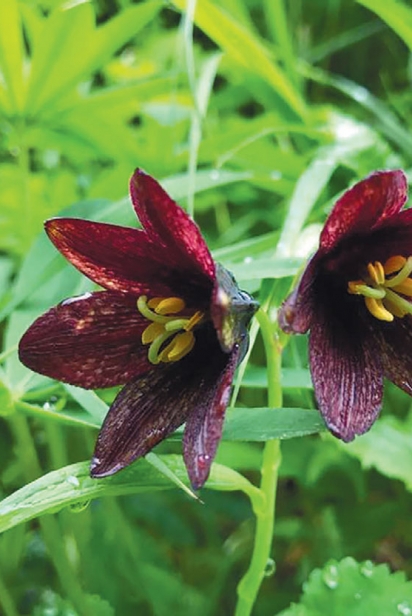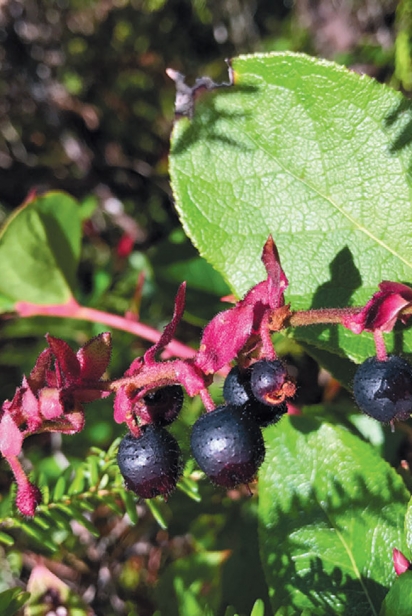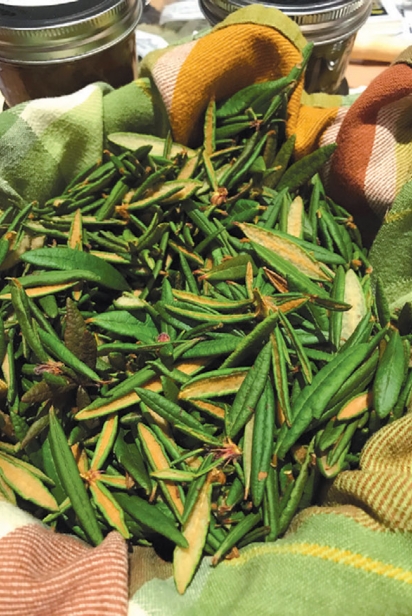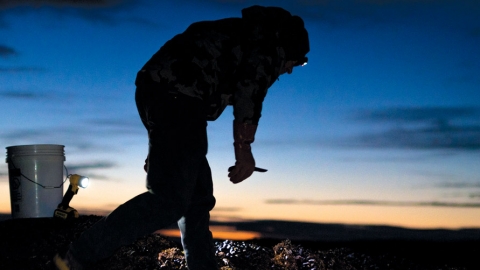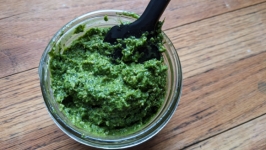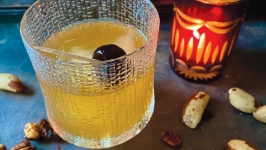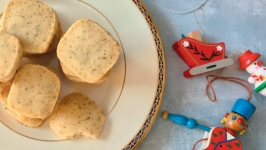Protecting What We Love
Editors’ note: in this piece, writer Nang Sḵat’áas Joseph Hillaire, Jr., reflects on the Alaska Traditional Plants Summit and Celebration which occurred last fall. When someone is mentioned who has both an Alaska Native name and an English name, those names are printed together with the Alaska Native name first. Tribal and clan affiliations, when noted, are in parentheses after a person’s name.
The deep drum sounded through my computer speakers, as if the heartbeats of our ancestors were joining all of us. On screen, tribal leaders sang and held a drum painted with an eagle, their faces and hands upturned with reverence. Kushakak’ Richard (Taantakwaan Teikweidi) and his wife Anchgwanutk’ Janice Jackson blessed the beginning of the Southeast Alaska Traditional Plants Summit and Celebration that was held October 1—3, 2020. Their singing voices reminded us how much knowledge we have and can still learn from our elders. The prayer song called us to celebrate what is special to us: our traditional edible and medicinal relatives, the plants.
In a world without a pandemic, this would have been an in-person gathering of Tlingit, Haida, and Tsimshian peoples from what is now Southeast Alaska to learn, appreciate, and network with each other about respectful harvesting practices. Although the summit was hosted via Zoom, participants still felt immense love and spiritual connection to each other.
Kushakak’ continued with a welcome message. “Today, we know that environments are going through changes. We must care for the land so that our animals can live on it. So our forests can grow, so our birds can fly. So we can enjoy being on it in all seasons. We must care for our sea because we get much of our food from it,” he said.
This regional summit continued the legacy of the Alaska Plants as Food and Medicine Symposium hosted by Meda DeWitt and colleagues at the Alaska Native Tribal Health Consortium, and also followed up on relationships and connections cultivated at the Remembering Who We Are: Traditional Plant and Food Symposium in 2019 sponsored by the Ketchikan Indian Community and organized by Kaasei Naomi Michalsen of Kaasei Training & Consulting. These gatherings initiated lifelong connections between the people, places, and plants wherever they lived.
“Traditional foods have the power to nourish our bodies, our families, and also our spirit,” said Kaasei, co-organizer of the 2020 summit. “Food connects me to the Creator, the land, place, and the people.” She opened each day by reading dialogue agreements from the First Alaskans Institute to set the intention of honoring the perspective and experience of each person. Kaasei co-organized the event with Jennifer Nu, the regional food systems catalyst with the Sustainable Southeast Partnership and Southeast Alaska Watershed Coalition. “Our respectful harvesting working group hoped for the summit to foster a foundation of respect and connection to the land and to the ancestors,” said Nu. “When we all agree [on] why traditional plants are important to our individual and collective well-being, we can work together to address concerns people face in their communities.”
K’ádangg (“wise ones” in Haida)
A highlight for many was listening to Tlingit, Haida, and Tsimshian elders share their wisdom and teachings. One of the elders spoke about the importance of traditional and medicinal properties of trees and how they have saved lives. Storyteller and elder Bob Sam from Sitka shared how plants are a breath of life. “As Tlingit people, we view plants as human beings. Human beings and plants all have the same spirit,” he said solemnly. “When we go into the forest or up in the mountains, we never feel alone. You feel that connection and it’s quite powerful.”
Speakers expressed that although people may have different harvesting methods, we share similar fears for the future of the plants and the animals. “One of our main rainforests in this world is where we live. It gives us life beyond measure,” said respected Tlingit-Haida elder, Sdaalth K’awaas Della Cheney (Keex’ Kwaan). “There’s so much value beyond money value here. It’s our spirit. It’s our physical being. It’s our mind. All of these things are so important to each individual on this planet.” She explained that her community is still feeling the effects of logging and clear cutting that took place over 50 years ago.
Another elder shared how much it saddened her to come across trees that she knew would die because people harvested the bark in a way that girdled them. Others witnessed plants wiped out of areas due to overharvest. To combat this, they advised people to not take more than what is needed, and to learn respectful ways of harvesting and interacting with the plants.
“Although I was learning Shm’algyack, my elders made sure I was learning about connections to the seas, to the rivers, to the forest, to our ancient ancestors, that it is tied together as a whole,” recalled Tsimshian storyteller and culture-bearer Ahl’lidaaw Terry Burr. “We can’t just always take from the land, take from the sea without giving back. There is a balance to be made. We can think about what we’re going to take and what we’re going to leave.” Plants will hopefully always protect the physical and spiritual well-being of Southeast Alaska Natives, as long as we practice our values of protecting these lands and waters.
(This section uses Shm’algyack words according to the orthography system developed by the elders of Metlakatla.)
Plants as food and medicine
Summit presenters shared different ways to respectfully use specific plants. The photo-filled presentation of renowned weaver and retired Haida-Tlingit marine biology professor, Sganggwaay Dolly Garza, illustrated how to harvest, preserve, and prepare delicious recipes from three common seaweeds. Other presentations included teas, muskeg plants, and “forgotten ancestral foods.” Plant walk videos created by the Indigenous ethnobotanists at Planet Alaska demonstrated respectful harvesting of plants, from earlier in the summer.
Despite the summit’s virtual nature, speakers emphasized that the best way to learn about plants is not from a PowerPoint presentation, or the Internet. “Our greatest teachers are waiting for you, right outside your door,” said Valerie Segrest (Muckleshoot), the Regional Director of Native Food and Knowledge Systems at the Native American Agriculture Fund (NAAF), which sponsored the summit. The event aimed to inspire everyone to spend time outside with wild plants and to develop relationships with knowledgeable Indigenous plant teachers in their own communities.
The celebration honored the legacy and leadership of the Kayaaní Commission at the Sitka Tribe of Alaska. Decades ago, a dedicated group of Tlingit elders came together to preserve and protect traditional ways and ancestral knowledge. Since then, the group has created harvesting guidelines and an ethnobotany field guide, hosted plant gatherings, and provided educational opportunities for the community. Current commissioners spoke about their government-to- government relationship with federal agencies, such as the National Park Service and the U.S. Forest Service. “We as tribal people should be right up there at the front table because the decisions that they are making affect our lives,” stated Bob Sam, a founding commissioner. “This commission gave special decision-making powers to our elders.” The group welcomes opportunities to support other communities in fostering respectful use of plants.
Indigenous economies
Indigenous economies of the past were based on distributing and exchanging foods, medicines, and materials from the natural environment with respect for plants and animals. Today, these economies also operate alongside the Western economic framework of capitalism. “It’s important to take the tools and the paths that our ancestors blazed for us and then figure out how to do that for those who are coming after us,” said Yéilk’ Vivian Mork, of Planet Alaska. “There’s a lot of different ways to look at this word ‘economy,’ trading, or bartering,” she said. “To me it is the reciprocity of value, of knowledge, time, and effort. It is very important to make sure that every single last thing that we make and are doing is with good intentions.” The pandemic has provided an unexpected opportunity. “I feel that we get to create completely new systems and also revitalize the old systems or strengthen the systems that are already there,” she explained. For example, Mork’s Hike, Harvest, and Heal program operates on an exchange based on reciprocity, which may be monetary contributions or non-monetary trades.
Gah Kith Tin Alana Peterson, the Executive Director of the nonprofit Spruce Root Community Development, spoke on how businesses can be a force for good when in alignment with Indigenous values. “The bottom-line profit isn’t necessarily the thing that matters the most,” she said. “In fact, businesses can thrive and do really well when they take into consideration the impact that they have in the world.” Triple bottom line businesses regard social and environmental responsibility to be equally as important as profit for success. All of the session’s speakers demonstrated a common desire for Indigenous values and worldview to benefit local livelihoods, respect culture, and be environmentally responsible.
Food sovereignty and healing
Community leaders showcased food sovereignty projects from Hoonah, Kake, Ketchikan, Prince of Wales, Sitka, and Maxłaxaała. Initiatives included protecting and increasing traditional food access. The tribal conservation district on Prince of Wales Island and the Native forest partnership projects in Hoonah and Kake blend traditional science and Western technical knowledge to manage resources for conservation, economic opportunity, and cultural preservation. Education is also critical for food sovereignty. Naomi Leask (Maxłaxaała) presented the Sm’algyax phrase, “Txa’nii goo habooldm ‘waatga da laxyuubm” which means “Everything we have comes from our land.” She elaborated, “This is the guiding light for everything I do as a Ts’msyen studies educator. Harvesting with kids offers teachable moments to demonstrate reciprocity, reinforce cyclical thinking, and demonstrate the importance of taking care of each other and the land.”
(This section uses Shm’algyax words according to the Dunn orthography system commonly used in Canada.)
Stronger together
Lillian Petershoare (Yanyeidí from T’aaku Kwáan) was one of many who attended the entire summit. She expressed her appreciation for highlighting the benefits of traditional foods and the relevance of plants to the human experience. “We can draw upon the strengths of our culture to approach the challenges we face.” She added, “During the pandemic, feelings of isolation can be problematic. It’s very important for us to strive for balance and hope now more than ever.” Songs of prayer and love accompanied by drumbeats closed this extraordinary space co-created over the course of three days. Kaasei’s concluding words expressed the spirit of summit and celebration. “Let us continue healing, connecting, and learning from one another. This is just a beginning.”
Gunalchéesh, Haw’aa, ‘Doyckshn, Nt’oyaxsn, Thank you. The organizers express their gratitude to all those who made the summit a success. Acknowledgements can be found at sustainablesoutheast.net/foodsystems/plantsummit.



